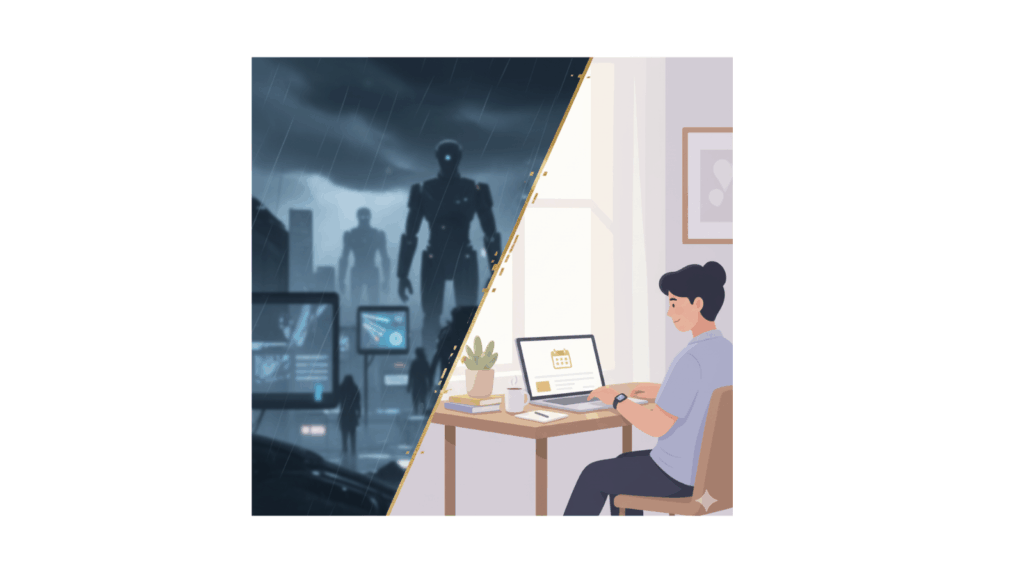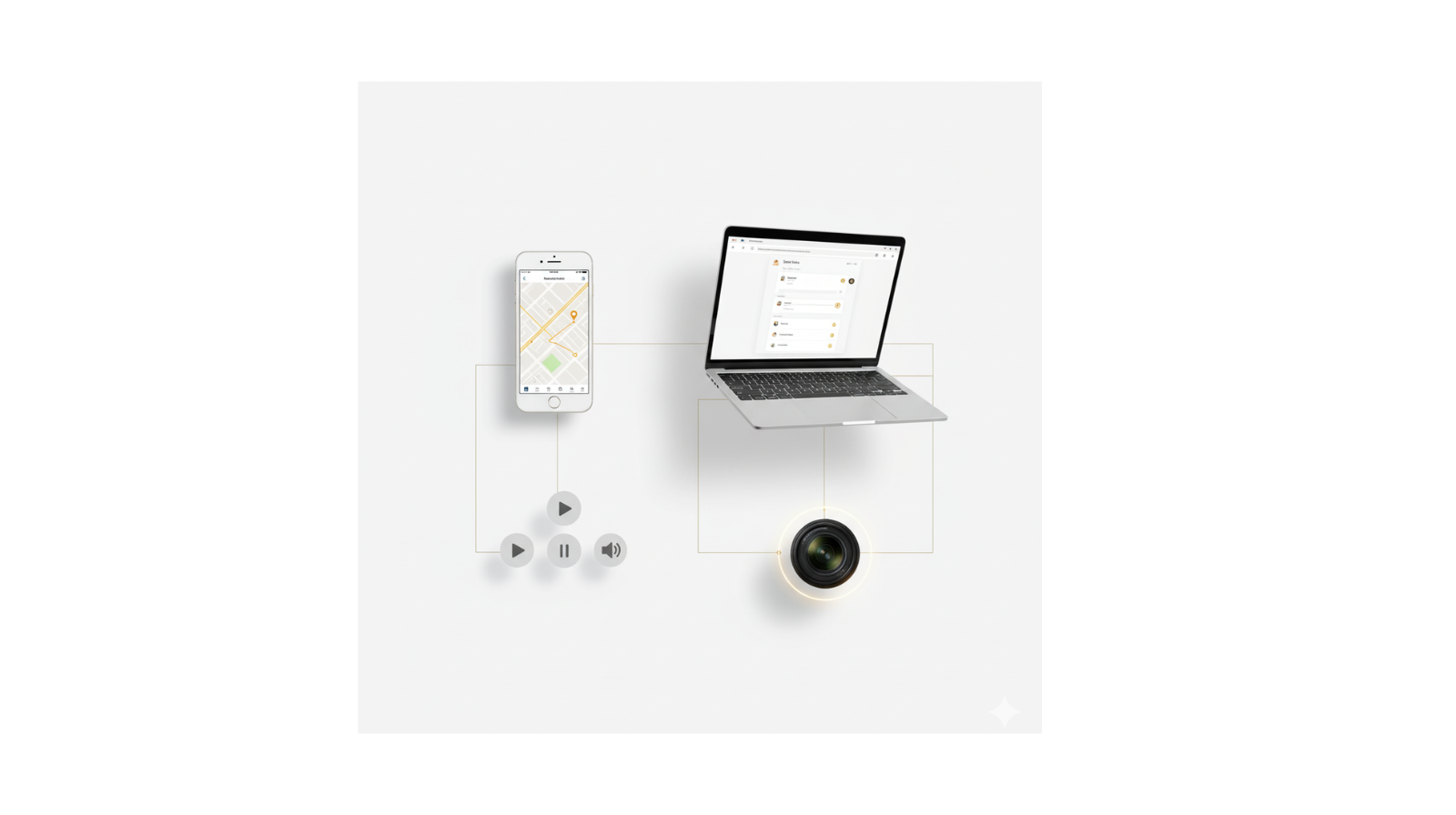When my daughters saw the new website I made, one of them said, “AI is scary.”
I paused—because they use it all the time without even thinking about it. Music playlists, photo filters, Google Maps? That’s all powered by AI.
That little moment made me realise something big: people are nervous about AI, even though it’s already part of everyday life. And here’s another thing, why we fear AI usually has less to do with machines and more to do with how new and uncertain it all feels. That fear isn’t new. We’ve always been cautious about change.
The Kind of Fear We Don’t Always Notice
When people hear “AI,” they often imagine creepy robots or machines taking over jobs. Movies like Terminator or Black Mirror really push that idea. News headlines don’t help either—some even say AI might “destroy humanity.”
However those stories are designed to grab attention, not to help us understand what’s really going on. As a result, familiarity softens fear, but education keeps it in check.
The truth? Most AI today does small, repetitive jobs. It doesn’t “think” like a person. It follows patterns and instructions really fast. Still, scary stories spread faster than calm facts, so fear often grows faster than understanding, in the end imagination fills in the blanks with worst-case ideas.
Why we fear AI – What Are We Really Afraid Of?

Some people say they’re scared AI will take jobs, steal data, or mess with fairness—and those are valid things to talk about.
But under all that, many of us are just afraid of losing control. We worry machines will start making all the decisions and we’ll get pushed aside.
The good news? That’s not what’s happening.
Humans still design AI anyway they decide how to use it, and set the rules. Learning how to control AI usage puts you back in charge, so the technology serves your goals, not the other way around In fact, many people already use AI daily, to plan their calendar, write emails, or brainstorm ideas.
According to a 2025 survey, over half of workers (52%) worry about AI and jobs, yet many already use AI at work. Familiarity softens fear, but education keeps it in check. As a result, awareness, not avoidance is what builds confidence.
Everyday AI That Already Helps You
Here’s the part that surprises most people, and it’s a big reason why we fear AI in the first place.
We imagine it as futuristic or dangerous, when really, it’s already quietly helping us every day.
Meanwhile you probably use AI without noticing it:
- Your GPS gives you a faster route.
- Your phone brightens the screen when you step outside.
- Netflix suggests a show.
- Spotify builds your playlist.
- Your bank flags a suspicious charge.
When we realise that AI is already part of normal life, why we fear AI starts to make more sense — we fear what we don’t recognise.

Understanding Technology Starts with Understanding Why We Fear AI
Fear grows in the dark; learning turns the lights on.
AI doesn’t “think.” It recognises patterns, like how your brain guesses the next word in a sentence. When it gets something wrong, it’s not tricking you; it’s guessing based on limited data.
That’s why it helps to double-check what you read, and to learn from balanced sources instead of clickbait headlines. The British Psychological Society has a great piece exploring why we fear AI and how understanding reduces anxiety. If you’d like to go further, Elements of AI offers free, beginner-friendly lessons that make learning about AI simple and safe
You don’t need to be an expert to feel safer. Knowing how AI works is like knowing how a car works, you don’t need to build the engine, but the basics make you a better driver.
Common AI Myths (And the Real Facts)
| Myth | Truth |
|---|---|
| AI will take every job. | It might replace some tasks, but it also creates new roles in design, writing, and tech. |
| AI can think like a human. | It can’t. It recognises patterns—it doesn’t feel or reason. |
| AI is always risky. | Trusted apps follow safety rules. Safety depends on how you use them. |
| Only tech experts can use AI. | Many tools are built for beginners and are simple to try. |
Learning Instead of Avoiding

If we ignore new things because they feel scary, we don’t grow.
But when we stay curious, we learn and feel stronger.
Learning about AI is like learning to ride a bike or use the internet, it’s clumsy at first, then natural. Start small: try one planner app or creative tool. Do it with family, share what you find, and turn fear into confidence.
AI is also opening doors for accessibility. Many tools help neurodiverse users or people with disabilities organise, write, and communicate more easily. It’s not just for “tech people”—it’s becoming a tool for inclusion.
What Makes Us Human Still Matters
Some people say AI is making us lazy. But really, it takes care of the boring stuff.
That gives us more time for the things only humans can do, thinking deeply, being creative, and caring for others.
It’s not about humans versus machines; it’s teamwork. Let the tech handle repetition and let us handle imagination and empathy.
Final Thoughts on Why We Fear AI
AI isn’t a distant future—it’s already here.
The real question is whether we’ll fear it or learn to use it.
Once you understand even a little, it feels far less scary. Try one beginner tool. Talk about it with someone close to you. Choose curiosity over worry.
You don’t have to master it overnight. Just start small. Every step helps.
Continue Learning
Keep exploring ideas at Everyday Mastery with AI, and if you’d like to anchor these insights in everyday action, download the free Small Habits Mini Guide from Everyday Mastery.
Curiosity doesn’t end with one article it’s a lifelong skill. Every small step you take to understand technology builds confidence and calm. If you’d like to keep exploring simple, safe tools that make learning easier, visit the AI Tools page on Everyday Mastery with AI. You’ll find beginner-friendly options to experiment with, one at a time no pressure, just progress.